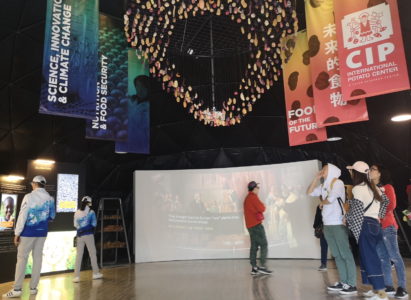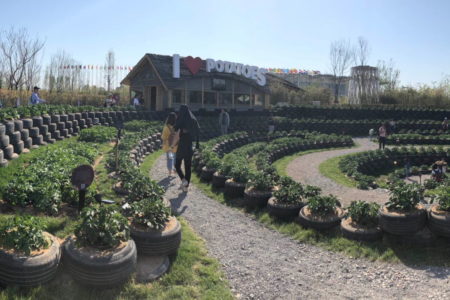 With an exhibit at the International Horticultural Exhibition (Expo 2019) in Beijing, the International Potato Center (CIP) aims to raise awareness of the benefits of potato and sweetpotato in China, highlighting the huge potential of the world’s fourth and sixth most important crops, respectively, to boost nutritional outcomes, raise incomes, and help farmers adapt to the challenges of climate change.
With an exhibit at the International Horticultural Exhibition (Expo 2019) in Beijing, the International Potato Center (CIP) aims to raise awareness of the benefits of potato and sweetpotato in China, highlighting the huge potential of the world’s fourth and sixth most important crops, respectively, to boost nutritional outcomes, raise incomes, and help farmers adapt to the challenges of climate change.
Expo 2019 was inaugurated on April 28 with a colorful ceremony and a speech by Chinese President Xi Jinping, who also led a group of heads of state through its exhibits. Hosted by the Chinese government and Beijing municipality, Expo 2019 is one of the highest profile international events to be held in China this year, with exhibits from 110 countries and international organizations.
“We’re very excited to be participating in Expo 2019 and expect that the coverage in Chinese media and visits by leaders of the country’s agricultural sector will greatly raise awareness of the potential of potato and sweetpotato to contribute to the achievement of the United Nations’ Sustainable Development Goals,” said Dr Barbara Wells, CIP Director General.
Over the next five months, an estimated 16 million people are expected to visit the Exhibition, located in Yanqing District, on the outskirts of Beijing. It covers 503 hectares along the Guishui River that have been transformed into a collection of gardens and pavilions under the theme “Live green, live better.”
CIP expects 1.4 million people to visit its Expo 2019 exhibit, which was built using recycled materials such as old tires and bottles, in accordance with Expo 2019 guidelines. The exhibit includes a multimedia dome and a representation of the Moray archaeological site, located high in the Andes Mountains in Peru. Moray consists of 20 concentric terraces, built by the Incas in the fifteenth century, that archaeologists believe were used for agricultural research. In collaboration with the Chinese Academy of Agricultural Sciences, the site was planted with potatoes at inauguration and will be also be planted with sweetpotatoes for the duration of Expo 2019.

“I hope that this will lead to new opportunities for research for development to benefit more people in China and the Asia Pacific region, as well as countries that span the Belt and Road Initiative – namely Central Asia, the Caucasus and of course Africa,” added Dr Wells.
The CIP exhibit features multimedia presentations about the potato’s origin in the Andes and the history of the crop’s dissemination across the globe over the past five centuries. Interactive presentations also include information about the many attributes of potato and sweetpotato and CIP’s use of those crops to strengthen food and nutrition security, promote inclusive employment growth, and improve the climate resiliency of farms across the developing world.
CIP has been active in China since 1978, and since 2017, CIP’s partnership with the Government of China has been heightened through the establishment of the CIP-China Center for Asia Pacific, a research campus in Yanqing, Beijing funded and built with Chinese government support. Approximately one fourth of all potatoes grown in China are of varieties that were either bred by CIP or developed in China using germplasm from CIP. One of those varieties, Cooperation 88, is grown on approximately 160,000 hectares and was estimated to provide benefits worth USD 2.84—3.73 billion to farmers and consumers in Yunnan province alone. CIP has also contributed to the breeding and utilization of sweetpotato in China, as it does in India and many countries in Africa.

